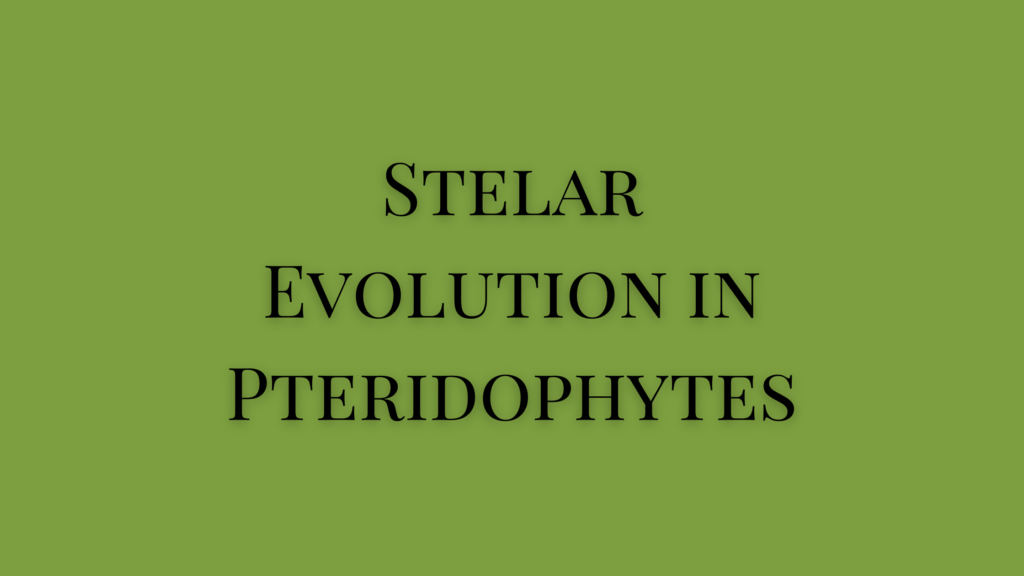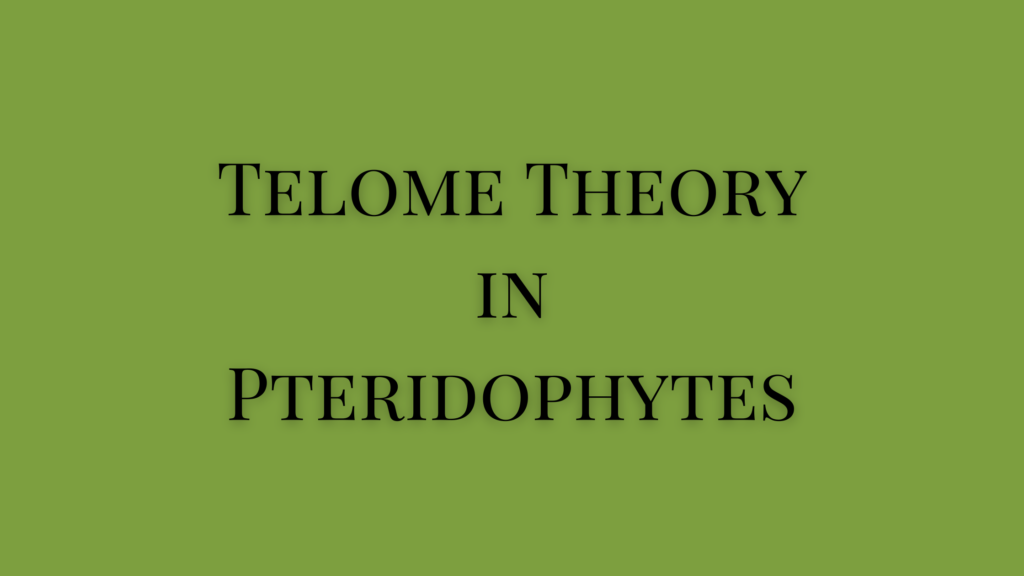The name ‘stele’ has been derived from a Greek word meaning ‘Pillar’. It refers to the different parts of the central region of the roots and stems in the vascular plants. The stelar evolution in pteridophytes is significant as they are the first plants that have developed vascular bundles.
Stelar Evolution in Pteridophytes
Earlier, plant anatomists believed that the fundamental unit in the vascular system was the vascular bundle in both pteridophytes and higher plants. However, in 1886 Van Tieghem and Douliot proposed the stelar theory.
According to them the primary bodies of the stem and root are alike in gross anatomy consisting of a central core- the stele- separated from the outer cortex by endodermis. The stele consists of the xylem, phone, pericycle, medullary rays, and the pith. In addition, leaf traces also play a crucial role in the vascular system of the axis.
Types of Stele
Two steles are identified- protostele and siphonostele. Each of these is further divided based on its characteristics.
Protostele
The basic type of stelar construction is that in which the vascular tissue is a solid mass, where the xylem forms the central core surrounded by phloem. Jeffrey named such a stele – Protostele. A protostele is the simplest type of stele which is considered to be phylogenetically primitive.
It is the fundamental stelar type for the tracheophytes in general and for the pteridophytes in particular. All other types of stele have been derived from it in the course of evolution. As far as is known all pteridophytes start with a protostelic stem.
In the stem of Rhynia, the protostele is small, consisting of a few tracheids and phloem elements. Such a stele has been designated as a primitive protostele. The protostelic condition is retained in the adult stems of Selaginella, Lycopodium, and Gleichenia.
Haplostele & Actinostele
Brebner (1902) suggested that protostele may be of two types- Haplostele and actinostele. In the haplostele, there is a smooth circular core of the xylem and the phloem forms a continuous layer surrounding it. Eg. Selaginella. A haplostele is supposed to be the most primitive than the actinostele.
In actinostele, the xylem has radiating ribs (stellate in C.S) and the phloem is present in solid masses alternating with the projecting angles of the xylem. Eg. Lycopodium serratum, Psilotum, etc. There may be variations in the actinostele also.
Plectostele
In L.volubile, the stem core is in the form of plant lobes lying parallel to one another, and the xylem and phloem are arranged in alternate traverse plates. Zimmermann (1930) calls such actinosteles as Plectosteles.
Mixed Protostele
In some species of Lycopodium such as L.cernum, the masses of xylem and phloem are uniformly distributed where the xylem groups are embedded in the phloem masses. Such protosteles are called mixed protosteles.
Protostele with mixed pith
In Gleichenia dichotoma, Lepidodendron selaginoides, L. intermedium, etc, the tracheids intermingled with thin-walled living parenchyma. Such a protostele is designed as a protostele with mixed pith. This is the first step in the formation of a pith.
Siphonostele
When the shoot grows bulky, accompanying an increase in size, there is an internal differentiation of the stele.
The first step is the appearance of parenchyma scattered in the xylem core and finally a central parenchymatous medulla or pith is developed in the original protostele and it becomes medullated as in some species of Lepidodendron (L.harcourt, L.obovatum). A stele of such structure in which the protostele medullated is known as a siphonostele.
Origin of Siphonostele from Protostele
The method by which medullation came about in a protostele and the formation of siphonostele is a debated question and two hypotheses have been put forward.
Interstelar origin of pith
According to Boodle, Gwyne-Vaughan Bower, Petry, Thompson, and others, the innermost vascular tissue has metamorphosed or transformed into parenchyma, forming the pith. Thus the hypothesis is chiefly supported by comparative and ontogenetic studies of fossils and living forms.
In the young stem of Anemia and Schizaea, it is found that at the base of the structure is typically protostele, and slightly higher the parenchymatous zone occupies the core of the xylem. This explains that some of the tracheary elements would have been transformed into parenchyma.
Extra stelar origin of pith
This was proposed by Jeffrey. The cortical parenchymatous tissue invaded from outside the stele in its phylogenetic evolution. The leaf and branch gaps are the openings through which invasion has occurred. In other words, the pith may be homologous with the cortex.
According to Jeffrey, in Psilotum and Tmesipteris, there is a very close similarity in the structure of the pith and cortex. Similarly in some species of Equisetum, dark brown sclerenchyma is found both in the cortex and pith.
Based on extra stelar theory, it is difficult to interpret the occurrence of mixed pith as well as the occurrence of polycyclic siphonostele.
Eames (1936) has summarized the whole situation in a non-committal way by saying that the pith of lycopsid ferns and that of some of the more primitive ferns are without a doubt, interstelar origin and that of higher ferns and other pteridopsida groups is probably extra stelar.
In a siphonostele, the pith holds the central part while the xylem and phloem form concentric cylinders outside the pith. A siphonostele can be of two types- ectophloic siphonostele and amphiphloic siphonostele.
- The ectophloic siphonostele has the xylem cylinder lying next to the pith and is surrounded by a phloem cylinder which is on the outside. Eg. Osmunda, Schizaea.
- In amphiphloic siphonostele, there are two cylinders of phloem, one lying external to the xylem cylinder and the other internal to the xylem. Eg. Marselia.
Leaf and Branch Gaps
A general feature of the siphonostele central cylinder in the Pteridosid plants is the appearance of parenchymatous areas or gaps in the tubular cylinder which persist for a limited distance.
Such parenchymatous areas in the vascular system of the stem located axially around and above the point of departure of leaf traces and branch traces are known as leaf gaps and branch gaps respectively.
In its simplest form, the siphonostele has no leaf gaps as in some species such as Selaginella. Such siphonostele which is devoid of leaf gaps has been termed clado siphonic, in contrast with phyllo siphonic condition in Polypodiophyta (Jeffrey).
In many Polypodiophyta the successive large leaf gaps overlap in their longitudinal extent to such a degree that the vascular cylinder of the stem appears dissected into a tubular network.
In the recent past there has been a discovery made in steles of many stems recapitulate the stele of their early ontogeny. Thus many stems are protostelic in their first formed portions and siphonostelic in the later formed portions.
Macedonia pectata offers a good example of recapitulation. In this case, as development progresses there is a transition from protostele to solenostele and then to polycyclic condition.
Types of Siphonostele
Solenostele
Siphonosteles which are perforated by scattered leaf gaps that do not overlap with each other are known as solenosteles (Gwyne Vaughan and Schoute). The solenostele may be ectophloic like Vittania or amphiphloic as in Marsilea and Dicranopteris.
- Ectophloic solenostele is derived from ectophloic siphonostele where the phloem is seen
- only on the side of the xylem.
- Amphiphloic solenostele is derived from the amphiphloic siphonostele where the phloem
- is seen on both sides of the xylem.
Dictyostele
The dictyostele is an advanced type over solenostele which is generally seen in higher ferns.
The vascular parts of a dictyostele between two neighboring leaf gaps appearing as separate strands are termed meristeles.
In a dictyostele, each meristele resembles a protostele in its general structure. Such a dictyostelic condition is different from polystele such as is found in many species of Selaginella.
In many Leptosporangiate ferns, there are gaps in the vascular cylinder of the stem which have no relation with the departure of leaf traces. Such gaps are known as perforations. A dictyostele in which there are perforated gaps in addition to the leaf gaps is called a perforated dictyostele. Eg. Polypodium.
The other type of dictyostele in pteridophytes consists of the development of several separate steles. Such a stele is called a polycyclic stele. Eg. Pteridium, Angiopteris, Marattia, etc.
Eustele
In addition to all these types of stele, there is another additional type of stele proposed by Brebner, the eustele. Eustele has a vascular system that has a ring of collateral or bicollateral strands including the pericycle and medullary ground tissue with the leaf gaps.
The intravascular areas are not delimited from one another. Eg. Equisetum. This is the stele type of the highly evolved vascular plants such as gymnosperms and dicotyledons.
Atactostele
The most complex stele is the atactostele in monocotyledons. Atactostele has scattered vascular bundles without any pith. It was George Brebner in 1902, who coined this term for the vein arrangement of the vascular bundles.
Polycyclic Stele
The polycyclic stele has vascular bundles in the form of two or more concentric rings. Typically, a polycyclic stele has a solenostele or a dictyostele. Pteridium aquilinum has two rings while Matonia pectinata has three.
Polystele
Some pteridophytes have more than one kind of stele, this condition is called polystele. Selaginella is an example of a polystelic condition.
The evolutionary changes in the stelar organization may be found within the limits of a single family or in a single genus. In the family Schizaeaceae the vascular organization may range from protostele to dictyostele. In certain species of Gleichenia, the steles vary from protostele to siphonostele.
The evolution of stelar organization has taken place along several independent lines ranging from protostele to siphonostele which is characterized. The transformation from siphonostele to solenostele, dictyostele reaches the culmination point with polycyclic stele in pteridophytes.
References
- Abraham P C. Bryophytes, Pteridophytes, Gymnosperms & Paleobotany. 2000. St. Mary’s Books & Publications.
- Unit 18: Telome Theory & Stelar Evolution
- https://adpcollege.ac.in/online/attendence/classnotes/files/1587712259.pdf


